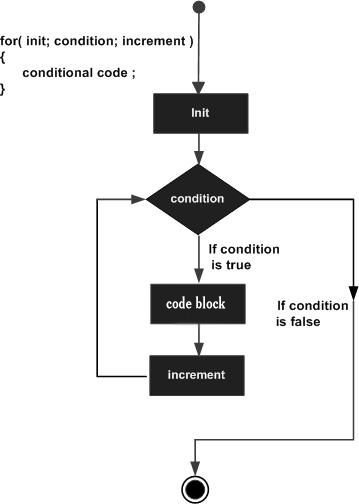for循环
for循环是重复控制结构。 它允许您编写需要执行特定次数的循环。
语法 (Syntax)
Go编程语言中for循环的语法是 -
for [condition | ( init; condition; increment ) | Range] {
statement(s);
}
for循环中的控制流程如下 -
如果condition可用,则只要条件为真,就执行for循环。
如果存在( init; condition; increment )的for子句则 -
init步骤首先执行,只执行一次。 此步骤允许您声明和初始化任何循环控制变量。 只要出现分号,就不需要在此处输入声明。
接下来,评估condition 。 如果为真,则执行循环体。 如果为false,则循环体不执行,控制流在for循环之后跳转到下一个语句。
在执行for循环体后,控制流会跳回到increment语句。 此语句允许您更新任何循环控制变量。 只要在条件之后出现分号,此语句就可以留空。
现在再次评估该条件。 如果为真,则循环执行并且过程自身重复(循环体,然后是增量步,然后是条件)。 条件变为false后,for循环终止。
如果range可用,则对该范围中的每个项执行for循环。
流程图 (Flow Diagram)

例子 (Example)
package main
import "fmt"
func main() {
var b int = 15
var a int
numbers := [6]int{1, 2, 3, 5}
/* for loop execution */
for a := 0; a < 10; a++ {
fmt.Printf("value of a: %d\n", a)
}
for a < b {
a++
fmt.Printf("value of a: %d\n", a)
}
for i,x:= range numbers {
fmt.Printf("value of x = %d at %d\n", x,i)
}
}
编译并执行上述代码时,会产生以下结果 -
value of a: 0
value of a: 1
value of a: 2
value of a: 3
value of a: 4
value of a: 5
value of a: 6
value of a: 7
value of a: 8
value of a: 9
value of a: 1
value of a: 2
value of a: 3
value of a: 4
value of a: 5
value of a: 6
value of a: 7
value of a: 8
value of a: 9
value of a: 10
value of a: 11
value of a: 12
value of a: 13
value of a: 14
value of a: 15
value of x = 1 at 0
value of x = 2 at 1
value of x = 3 at 2
value of x = 5 at 3
value of x = 0 at 4
value of x = 0 at 5
